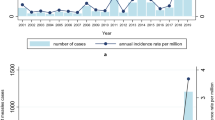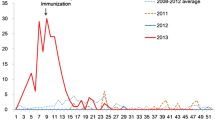Abstract
A sensitive, specific and timely surveillance is necessary to monitor progress towards measles elimination. We evaluated the performance of sentinel and mandatory-based surveillance systems for measles in Switzerland during a 5-year period by comparing 145 sentinel and 740 mandatory notified cases. The higher proportion of physicians who reported at least one case per year in the sentinel system suggests underreporting in the recently introduced mandatory surveillance for measles. Accordingly, the latter reported 2–36-fold lower estimates for incidence rates than the sentinel surveillance. However, these estimates were only 0.6–12-fold lower when we considered confirmed cases alone, which indicates a higher specificity of the mandatory surveillance system. In contrast, the sentinel network, which covers 3.5% of all outpatient consultations, detected only weakly and late a major national measles epidemic in 2003 and completely missed 2 of 10 cantonal outbreaks. Despite its better timeliness and greater sensitivity in case detection, the sentinel system, in the current situation of low incidence, is insufficient to perform measles control and to monitor progress towards elimination.
Similar content being viewed by others
Abbreviations
- CI:
-
Confidence interval
- FMH:
-
Swiss Medical Association
- FOPH:
-
Federal Office of Public Health
- MNS:
-
Mandatory notification system
- OR:
-
Odds ratio
- SSSN:
-
Swiss Sentinel Surveillance Network
- WHO:
-
World Health Organization
References
WHO regional Office for Europe. Health21—the health for all policy for the WHO European Region. Copenhagen: WHO regional Office for Europe; 1999.
World Health Organization and Regional Office for Europe. Strategic plan for measles and congenital rubella infection in the European region of WHO. Copenhagen: World Health Organization and Regional Office for Europe; 2003.
Featherstone D, Brown D, Sanders R. Development of the global measles laboratory network. J Infect Dis 2003;187(Suppl 1):S264–9.
Hanon FX, Spika JJ, Wassilak SS, Emiroglu N. WHO European Region’s strategy for elimination of measles and congenital rubella infection. Euro Surveill 2003;8:129–38.
Bonmarin I, Levy-Bruhl D. Measles in France: the epidemiological impact of suboptimal immunisation coverage. Euro Surveill 2002;7:55–60.
Ciofi Degli Atti ML, Salmaso S, Bella A, Arigliani R, Gangemi M, Chiamenti G, et al. Pediatric sentinel surveillance of vaccine-preventable diseases in Italy. Pediatr Infect Dis J 2002;21:763–8.
Gabutti G, Rota MC, Salmaso S, Bruzzone BM, Bella A, Crovari P. Epidemiology of measles, mumps and rubella in Italy. Epidemiol Infect 2002;129:543–50.
Tischer A, Santibanez S, Siedler A, Heider A, Hengel H. Laboratory investigations are indispensable to monitor the progress of measles elimination-results of the German Measles Sentinel 1999–2003. J Clin Virol 2004;31:165–78.
Richard JL, Boubaker K, Doutaz M, Schubiger G. Obligatorische Meldepflicht für Masern in der Schweiz: starker Anstieg der Anzahl Fälle im Früjahr 2003/Déclaration obligatoire de la rougeole en Suisse: forte augmentation du nombre de cas au printemps 2003. Schweizerische Ärztezeitung/Bulletin des médecins suisses 2003;84:1439–50.
Matter HC, Flückiger H, Pfiffner D, Cloetta J, Stürchler D. Sentinella Arbeitsgemeinschaft. Zehn Jahre Monitoring durch Impfung verhütbarer Krankheiten im Schweizerischen Sentinella System/Système suisse Sentinella: Dix ans de surveillance des maladies vaccinales. Bull BAG/OFSP 1997;38:8–10.
Harcourt SE, Edwards DE, Fleming DM, Smith RL, Smith GE. How representative is the population covered by the RCGP spotter practice scheme? Using geographical information systems to assess. J Public Health 2004;26:88–94.
Ciofi Degli Atti ML, Arigliani R, Calia V, Carbonari P, Cobianchi F, D’Argenio P. Sentinel pediatric surveillance in Italy: results from 2000. BEN 2001;14. http://www.epicentro.iss.it/ben/precedenti/maggio/2_en.htm.
Ciofi Degli Atti ML, Salmaso S. Measles increase in Italy. Eurosurveillance weekly 2002;6.
Ciofi Degli Atti ML, Fabi F, Salmaso S. Centers for Disease Control and Prevention (CDC). Measles epidemic attributed to inadequate vaccination coverage—Campania, Italy, 2002. MMWR Morb Mortal Wkly Rep 2003;52:1044–7.
Hellenbrand W, Siedler A, Tischer A, Meyer C, Reiter S, Rasch G, et al. Progress toward measles elimination in Germany. J Infect Dis 2003;187(Suppl 1):S208–16.
Brücker G. Rougeole: déclaration obligatoire et nouvelles mesures vaccinales. Bull Epidemiol Hebd 2005;41–42:205–12.
Matter HC, Cloetta J, Zimmermann H. Sentinella Arbeitsgemeinschaft. Measles, mumps, and rubella: monitoring in Switzerland through a sentinel network, 1986–94. J Epidemiol Community Health 1995;49(Suppl 1):4–8.
Paget JW, Zimmermann H, Vorkauf H. Sentinella Arbeitsgemeinschaft. A national measles epidemic in Switzerland in 1997: consequences for the elimination of measles by the year 1997. Euro Surveill 2000;5:17–20.
Clarkson JA, Fine PEM. The efficiency of measles and pertussis notification in England and Wales. Int J Epidemiol 1985;14:153–68.
Siedler A. Masern-Surveillance mit zwei Erfassungssystemen. Epidemiol Bull 2001;295–8.
Jajosky RA, Groseclose SL. Evaluation of reporting timeliness of public health surveillance systems for infectious diseases. BMC Public Health 2004;4:29. doi 10.1186/1471-2458-4-29.
Jansson A, Arneborn M, Skarlund K, Ekdahl K. Timeliness of case reporting in the Swedish statutory surveillance of communicable diseases 1998–2002. Scand J Infect Dis 2004;36:865–72.
Jansson A, Arneborn M, Ekdahl K. Sensitivity of the Swedish statutory surveillance system for communicable diseases 1998–2002, assessed by the capture-recapture method. Epidemiol Infect 2005;133:401–7.
Papania MJ, Strebel PM. Measles surveillance: the importance of finding the tip of the iceberg. Lancet 2005;365:100–1.
Trottier H, Carabin H, Philippe P. Proportion des déclarations de cas de rougeole, de coqueluche, de rubéole et d’oreillons aux systèmes de surveillance. Evaluation des études pour les pays industrialisés. Rev Epidemiol Sante Publique 2006;54:27–39.
Six C, Franke F, Mantey K, Zandotti C, Freymuth F, Wild F, Parent du Châtelet I, Malfait P. Measles outbreak in the Provence—Alpes—Côte d’Azur region, France, January–July 2003. Euro Surveill 2005;10:46–8.
Schmidt K, Ernst E. MMR vaccination advice over the Internet. Vaccine 2003;21:1044–7.
Schlaud M, Brenner MH, Hoopmann M, Schwartz FW. Approaches to the denominator in practice-based epidemiology: a critical overview. J Epidemiol Community Health 1998;52(Suppl 1):13S–9S.
Richard JL, Zimmermann HP. Recent increase in measles in children and teenagers in Switzerland. Eurosurveillance weekly 2003;7.
Acknowledgements
The authors gratefully acknowledge the Swiss physicians and laboratories participating in the sentinel and the mandatory notification systems for measles. Thanks are also due to the Federal Office of Statistics and santésuisse for providing population and medical consultations data respectively. The authors warmly acknowledge Dr. Marcel Zwahlen of the Department of Social and Preventive Medicine, University of Bern, as well as Dr. Hanspeter Zimmermann of the Federal Office of Public Health for critically reviewing the manuscript.
Author information
Authors and Affiliations
Corresponding author
Rights and permissions
About this article
Cite this article
Richard, JL., Vidondo, B. & Mäusezahl, M. A 5-year comparison of performance of sentinel and mandatory notification surveillance systems for measles in Switzerland. Eur J Epidemiol 23, 55–65 (2008). https://doi.org/10.1007/s10654-007-9187-1
Received:
Accepted:
Published:
Issue Date:
DOI: https://doi.org/10.1007/s10654-007-9187-1




